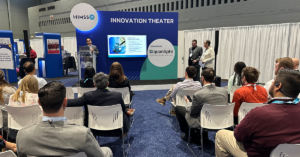Data fabric is a term that is growing in recognition throughout technology spaces, but most healthcare leaders still have questions about what data fabric encompasses and why it matters for their organizational success. In this blog post, we’ve distilled a compelling conversation between MedeAnalytics leaders Andy Dé (Chief Marketing Officer), David Bartley (Chief Product Officer), and Sree Ghantasala (Chief Technology Officer) to bring you answers to the 5 top data fabric FAQs we receive from our clients.
Before diving in, remember that data fabric is, as IBM defines, “architecture that facilitates the end-to-end integration of various data pipelines and cloud environments through the use of an intelligent and automated system.” To put it more simply, think of the different threads of the data fabric (e.g., interoperability, visualization, predictive analytics, augmented analytics, benchmarking) woven together to create a unified, comprehensive view of all the information your teams need to make smart, high quality decisions.
FAQ #1: Is data fabric critical to growth or more of a ‘nice-to-have’?
Most analytics innovations have been perceived as add-ons more than essentials, but this tide of opinion is rapidly changing. In fact, it’s estimated that by 2025, 80% of all chief data analytics officers will have adopted data fabric as a core element of their value-based care advancement strategies.
Data—particularly in healthcare—is always coming from different places, in different formats, with different access procedures and different interpretation guidelines. To understand and apply data holistically, healthcare organizations must adopt a more interoperable, seamless and comprehensive approach to data sourcing, data integration and data management.
FAQ #2: What happens if we change vendors or switch data collection processes? Is data fabric going to stick with us through those shifts?
We can’t speak for all technologies, but MedeAnalytics’ data fabric is designed to evolve with any vendor or process changes payers and providers make. Our agnostic approach to data aggregation and analysis allows us to work with diverse partners across the ecosystem, ensuring that your investments sync and are future-proofed. Technology advances quickly and standards are always in flux, so it’s critical to have a flexible data fabric that can grow with you.
FAQ #3: How does data fabric contribute to value-based care initiatives and population health goals?
Healthcare is incredibly personal, and a value-based, population-driven approach to it requires organizations to tailor objectives and measures to their locations and communities. The secure yet flexible nature of data fabric allows payers and providers to accelerate and augment their existing efforts without disrupting workflow or wasting time. Additionally, the cloud infrastructure of data fabric enables easier scalability and adaptability. These advantages are crucial for improving working relationships between payers and providers as well by consolidating the most important information to support quality, analytics-driven decision-making.
FAQ #4: What do data fabric and AI have to do with each other?
While data fabric architecture brings all your necessary components together, AI helps you get the most out of them. AI relieves burden and enhances efficiency for your teams by proactively assessing the data and offering valuable suggestions for next steps. Think of the way Amazon shows you customized suggestions—based on your behavior and input—for what you may want to look at or consider buying. AI plays a very similar role by building on the broad base of information within data fabric and drawing your attention to key trends, indicators and intelligence that would have taken weeks and many resources to surface otherwise.
FAQ #5: What does data fabric do for executives? Or, is it just helpful for end-users and managers?
The foundation of data fabric—and the powerful analytics solutions that are constructed on it—have immense potential to support real-time decision-making at all levels. For executives, a unified data fabric enables the creation of a single, simplified strategic dashboard to track initiatives across the organization and drive consensus and consistency throughout the C-suite team.
These FAQs are just a glimpse at the elaborate entity that is data fabric. Contact our team to have a 1:1 consultation about what you could build on MedeAnalytics’ data fabric foundation.
Get our take on industry trends
Best practice tools to build an integrated approach to multimorbidity
The traditional model of treating single diseases no longer works. Data collected from 2016 to 2019 indicated that 32.9% of…
Read on...Will adopting a risk-based approach with augmented analytics support care gap closure?
A common challenge for healthcare systems is how to properly segment its patient populations based on risk profiles and co-morbidities. Doing this well ensures a high quality of care delivery and superior patient outcomes.
Read on...4 questions healthcare executives are asking about augmented analytics
At our annual Impact Summit, I had the privilege to talk about augmented analytics and address questions from healthcare executives—many…
Read on...


